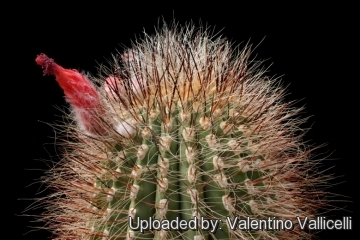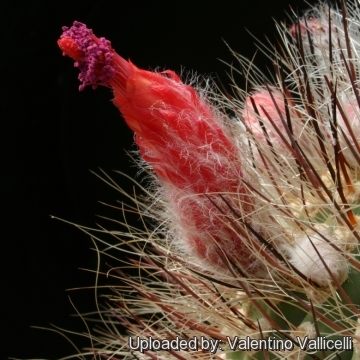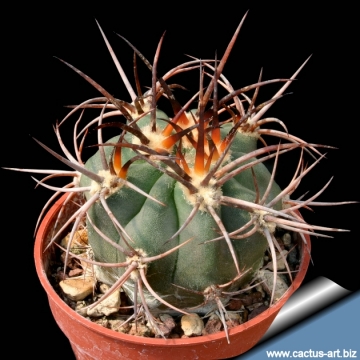= Denmoza erythrocephala (K.Schum.) A.Berger
Kakteen (Berger) 146, 339 (1929). (A.Berger)
Accepted Scientific Name: Denmoza rhodacantha (Salm-Dyck) Britton & Rose
Cactaceae (Britton & Rose) 3: 79. 1922 [12 Oct 1922] Britton & Rose

Echinocactus erythrocephalus (Denmoza erythrocephala) Photo by: Valentino Vallicelli
It is a barrel type of cactus with extraordinary scarlet zygomorphic, tubular flowers it is a very variable species.
Origin and Habitat: Denmoza erythrocephalaSN|7993]]SN|8000]] (= Denmoza rhodacanthaSN|7993]]SN|7993]]) is widespread throughout the mountains of Argentina, where it occurs in Mendoza, San Juan, La Rioja, Tucumán, Catamarca and Salta.
Altitude range: This species at elevations between 800 and 2800 metres of elevation above sea level.
Habitat: Eastern slopes and foothills on monte habitat, in gravel soils , together with Cereus aethiopsSN|7679]]SN|6944]], Echinopsis leucanthaSN|8246]]SN|8246]], Opuntia sulphureaSN|32053]]SN|32053]], Maihueniopsis glomerataSN|7342]]SN|7342]], Eriosyce strausianaSN|18]]SN|18]] and TrichoSN'> 7680' alt='6944'>Cereus candicans#SN#7679'>Tricho[[Cereus candicansSN' style='border:none;'>. Denmoza rhodacanthaSN|8000]]SN|7993]] has a wide range, is locally abundant, is present in several protected areas, and is not utilised. The major threats to this species are mining activities and fires.
7680' alt='6944'>Cereus candicans#SN#7679'>Tricho[[Cereus candicansSN' style='border:none;'>. Denmoza rhodacanthaSN|8000]]SN|7993]] has a wide range, is locally abundant, is present in several protected areas, and is not utilised. The major threats to this species are mining activities and fires.
Synonyms:
See all synonyms of Denmoza rhodacantha
back
Accepted name in llifle Database:Denmoza rhodacantha (Salm-Dyck) Britton & RoseCactaceae (Britton & Rose) 3: 79. 1922 [12 Oct 1922]Synonymy: 11
Cultivars
(2):
back
Description: Demnozas grow slowly and stay globulous during a long period before becoming shortly column-shaped, 0.5 to 1.5 cm high. The plant's diameter ranges from 15 to 30 cm, the stem colour varies from pale green to dark green, with 15 to 30 ribs. They need to reach a reasonable size in cultivation before producing their flowers. First flowers appear, however, on plants of very unequal age and size, some time on relatively young plants but also on 30-40 years old specimens! Flowers are zygomorphous, of a maximum length of 7.5 cm, reddish in colour and have white hair on the tube. The flower open sufficiently widely so that the stigma and stamen are visible from outside.
Notes: The genus Denmoza comprises only one species. The plants described as Pilocereus erythrocephalusSN|8001]]SN|8001]] and later transferred to Denmoza has sometimes, for instance by Backeberg, been considered as another species of the genus. Denmoza rhodacanthaSN|7993]]SN|7993]] changes considerably in the habit with age. The description of Denmoza rhodacanthaSN|7993]]SN|7993]] refers to young plants having strong spines in areoles. Old plants of the same species with multiple number of spines and sometimes with thin, 6 cm long bristly spines correspond to the description of Denmoza erythrosepala.
Bibliography: Major references and further lectures
1) N. L. Britton, J. N. Rose: “The Cactaceae. Descriptions and Illustrations of Plants of the Cactus Family.” Vol I, The Carnegie Institution of Washington, Washington 1919
2) Edward Anderson “The Cactus family” Timber Press, Incorporated, 2001
3) James Cullen, Sabina G. Knees, H. Suzanne Cubey "The European Garden Flora Flowering Plants: A Manual for the Identification of Plants Cultivated in Europe, Both Out-of-Doors and Under Glass" Cambridge University Press, 11/Aug/2011
4) David R Hunt; Nigel P Taylor; Graham Charles; International Cactaceae Systematics Group. "The New Cactus Lexicon" dh books, 2006
5) Méndez, E. & Ortega-Baes, P. 2013. Denmoza rhodacantha. The IUCN Red List of Threatened Species. Version 2014.3. <www.iucnredlist.org>. Downloaded on 12 April 2015.
 Echinocactus erythrocephalus (Denmoza erythrocephala) Photo by: Valentino Vallicelli
Echinocactus erythrocephalus (Denmoza erythrocephala) Photo by: Valentino Vallicelli Echinocactus erythrocephalus (Denmoza erythrocephala) Photo by: Valentino Vallicelli
Echinocactus erythrocephalus (Denmoza erythrocephala) Photo by: Valentino Vallicelli Echinocactus erythrocephalus (Denmoza erythrocephala) Photo by: Cactus Art
Echinocactus erythrocephalus (Denmoza erythrocephala) Photo by: Cactus Art - The young plants have only few strong spines. Old plants with thin long bristly spines correspond to the description of D. erythrosepala. (Denmoza erythrocephala) Photo by: Cactus Art
- The young plants have only few strong spines. Old plants with thin long bristly spines correspond to the description of D. erythrosepala. (Denmoza erythrocephala) Photo by: Cactus ArtCultivation and Propagation: D. rhodacantha/erythrocephala is a summer grower species that offers no cultivation difficulties, though very slow growing. Water regularly in summer (but do not overwater ) needs good drainage and very porous soil, keep rather dry in winter. Feed with a high potassium fertilizer in summer. It is quite frost resistant if kept dry (hardy to -7° C). Need a bright exposure, full sun or half shade in summer.
Propagation: Direct sow after last frost as usually fail to produce offsets.














